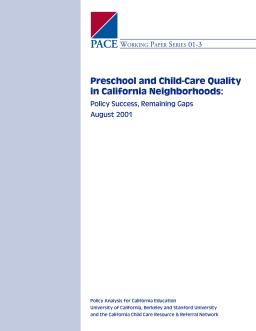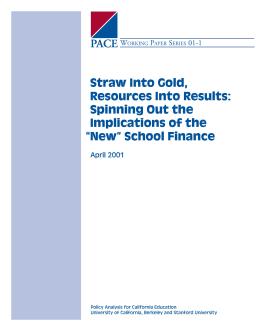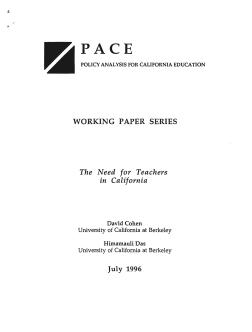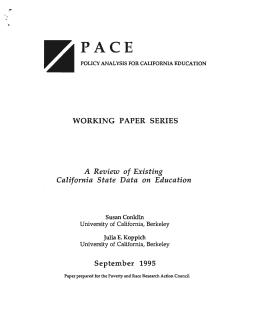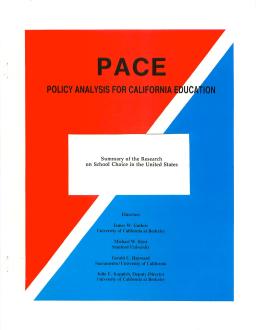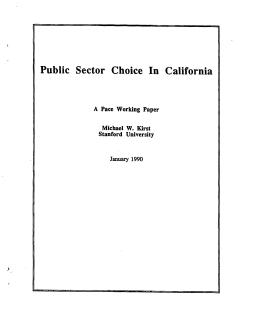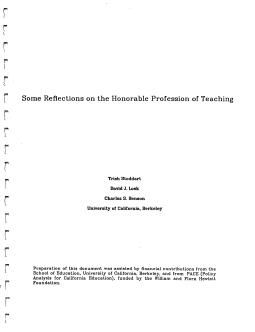Published
Summary
This report discusses an initiative by the California Children and Families Commission to expand the availability and quality of early care and education programs. The project includes recruiting and training early care providers, improving professional preparation, and implementing strategies to retain trained providers. The report provides information on existing training programs available to early childhood professionals and students, including accredited/non-accredited opportunities at community colleges, state universities, private colleges, and child care resource and referral agencies.
Policy Success, Remaining Gaps
Published
Summary
This paper analyzes the quality of center-based programs in diverse lower-income communities in California. The majority of centers displayed high levels of quality, and community conditions such as poverty levels and ethnic composition did not consistently influence quality. Public subsidies positively affected center quality, while the presence of more programs in a community may slightly lower quality due to increased demand for enrollment.
Focusing on San Francisco and Santa Clara Counties
Published
Summary
This report analyzes California's early childhood education programs and finds that attending public preschool programs improves school readiness and academic performance, particularly for low-income children. The study also shows that the economic benefits of preschool programs far outweigh the costs, including increased earnings and decreased need for remedial education and social services. Recommendations include expanding access to high-quality preschool programs for low-income children in California to reduce economic inequality.
Spinning Out the Implications of the 'New' School Finance
Published
Summary
The "new" school finance approach investigates how resources are used within schools and classrooms to enhance educational outcomes, rather than focusing solely on spending patterns. The report reviews literature on resource use in education and suggests that additional funding is not sufficient to improve outcomes. Research should analyze how resources are used within classrooms and schools. Policymakers should develop complementary reforms and enact categorical funding. The report warns that education expenditures keep expanding with little to show for them.
Published
Summary
This baseline analysis examines the projected need for teachers in California based on student enrollment projections, expected rates of new teachers and teacher retirements. However, it does not take into account recent policy changes such as the budget's call for reductions in class size or the proposed changes to teacher credentialing requirements. These changes will impact the need for teachers in California. The analysis shows regional teacher shortages, which are expected to persist despite the new policies.
Published
Summary
The 1995-96 California state budget increased K-12 education funding by $1 billion, but the additional funds were meant to be used for non-recurring expenses like deferred maintenance and facility upgrades. Lottery revenues were also intended for non-recurring expenses, but schools have come to rely on them for their core instructional program, despite decreasing revenues. This paper reviews the history of the California State Lottery as a funding source for schools and how non-recurring costs are interpreted in a system with shortfalls in core programs.
Published
Summary
This report is part of the Poverty and Race Research Action Council's state data reconnaissance project, which aims to provide a guide to education data available in California for researchers and policymakers. PACE gathered the education data, which is presented in a catalogue of raw data sets and published reports from state, federal, and non-governmental agencies, along with a matrix showing which data are collected by which sources. Appendices provide more detail on specific data sets.
Published
Summary
The paper provides a synthesis of existing literature on school choice, with a focus on research that informs public policy development and evaluation. It presents information without taking a position for or against school choice and is intended for policymakers, parents, educators, and the public. The paper covers six sections, including types of school choice programs, efficacy, economic theories, private schools, public opinion, and unresolved research questions.
A PACE Working Paper
Published
Summary
California saw renewed interest in the issue of education choice in the late 1980s, with 11 bills introduced in the 1989 legislative session. The primary reason for this is the reluctance to consider public aid to private schools. California State Superintendent Bill Honig proposed AB 2134, which would require parents to choose a public school each year. The politics of choice have changed, and low-cost proposals that don't promote alternative school sites have become popular. This paper analyzes the California bills and their implications for education choice in California.
Published
Summary
California is at a critical juncture in education, needing up to 190,000 new teachers by 1991 and replacing 75% of the teaching force. Recommendations to improve teaching quality are proposed in this paper, focusing on changes in certification, professional training, and career structure. The state has the opportunity to ensure quality education for the 77 million students who will be taught by these new teachers.

